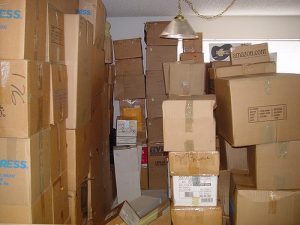“Where did all this stuff come from anyway? How did it all fit in here in the first place? I can’t believe how long this is taking and how many boxes we have! AAAaahhhh!!!!”

Well, it’s true. When we pull everything out of its storage space, we can see the volume of what we really have. And, for those things that haven’t been seen or touched in years: much of it is astonishing.
“Cans of hairspray? Wait. I haven’t bought hairspray in a can in at least 2…uh, 5…oh, I don’t know – better throw that out. How did these shoes get back here? Man, they’re dusty. And sort of misshapen. Well, okay very misshapen. Nevermind. Out! And, wait. Do we really have 6 new containers of black pepper? Six? I had no idea. This will last us forever!”
You are moving into a new home. Whether larger or smaller than your last, it’s an opportunity to get organized – right from the start! Here are 6 spaces to set up when you move in so you can get and stay organized:
Spice Storage: There are so many options for organizing spices that there is really no reason you need to fight to find what you need, have bottles and jars falling out onto you as you reach behind, or repurchase multiples of what you already have. 
Pantry: DIY or go the extra mile and get pro-installation. A pantry organizing system will be a delight to your family today and a great selling point tomorrow.
Under Sinks: Either in the kitchen or bathrooms, under sink storage will make ALL the difference. Enjoy the control and say goodbye to yucky under-sink messes!
Shoes: The struggle is real. First decide where you want to store them (By the entryway? In a closet? Under the bed? In the garage?) Then, reign them in.
Bedroom Closets: If you are renting a home, you may want to save money and purchase some temporary solutions that you can take with you when you move out. For homeowners, installing built-ins is the way to go.
Storage Area: Before you go building columns and walls of heavy boxes stacked one atop another; stop and think. This is what got you into the last mess of storage chaos. Is there room for some shelving? Is there ceiling or wall space to be taken advantage of?
Is it possible to live in a small area? You bet it is!
Most of us know people living in small houses or apartments, going to college and living in a dorm for the first time, or moving from a big home to a smaller one. Even if you don’t, you may have experienced one of these situations yourself at some point.
Did you feel challenged trying to fit everything in your new space? Does the person you know feel challenged trying to do the same thing?
If you follow these five (5) tips, it really is easier than you think:
1. Divide the space into specific areas for each activity (e.g., bill paying, watching TV, hobbies, laundry, reading, or studying). Furniture and rugs can be used to separate the different activities. For instance, your bedroom may have to act as an office plus a place to sleep and get dressed. Use a desk and file cabinet in one area of the room and the bed, bureau, and night stand in another. Keep the items in their specified areas; do not let them wander into the other activity areas.
2. Use milk crates on shelves that allow of extra space between them and the ceiling. Position the milk crate so the opening faces out. This way you’ll be able to store things both inside the milk crate and on top of it. It acts as a second shelf.
3. Use over-the-door storage units or command strips to hang things on the back of doors, in closets or on walls. You can hang items in or on them to get the items off your bed, chair, table, or desk. Don’t let them end up on the floor. The best part about command strips is that they do not damage the walls.
4. Use wall shelves to take advantage of vertical space. You can use your walls from floor to ceiling for storage.
5. Take advantage of the space under your bed. Use clear plastic bins that are specifically designed for under the bed. Measure the amount of clearance you have between the floor and the bed frame to make sure the bin fits. An option that affords you more storage space is raising the bed.
Just think, when living in a smaller area, you’ll have less to take care of. That frees up your time to do the things you want to do!
 Brrrr…it’s cold in most of the country. We spend more time indoors. What’s your favorite indoor activity? I bet reading immediately sprang to mind!
Brrrr…it’s cold in most of the country. We spend more time indoors. What’s your favorite indoor activity? I bet reading immediately sprang to mind!
Is your book collection organized so you can find just the right book you’re in the mood to read? Excellent! Or like many folks, are books scattered around the house? Do you even know what books you have? Do you regularly purge unwanted books or let them continue to occupy valuable space and collect dust?
Now is a great time to organize your books. Here are 11 tips.
My largest book organizing project was 17 years ago with my first client. In his library he had between 1,000 and 2,000 books. They were out of order. There were duplicates and triplicates. His library was completely nonfunctional. It took time, but after donating many of them and organizing the rest according to my client’s preferences, that massive job got done. My client was thrilled to have a functional library that looked great too!
For my personal collection, I mix it up. Fiction books are arranged in alphabetical order by author’s last name. Books in other categories (such as organizing, business and design) are separated by category but not in any order. Some books are vertical. Some are horizontal. Small framed photos and pieces of art add to the overall look. I donate books that no longer interest me. My book collection is functional and attractive. With a little time and effort, yours can be too.
Downsizing and organizing your books is worth doing. Then, when planning your next vacation, you can quickly grab the ones you want to read – much better than wasting time searching around the house or wasting money buying more at the airport.
Click on the above title to learn more about the featured author.
 Tips for getting your home ready for
Tips for getting your home ready for
OPEN HOUSE!
After the holiday rush is over and you’ve carefully packed your holiday decorations away, you may want to prepare now for spring. Spring, of course, is the perfect time to put your home up for sale.
Here are 5 tips to get your home ready that are often overlooked:
 Clean & update your trash cans and re-cycling center. This area is often neglected and you don’t want any unwanted odors lingering in the home. Recycling should be neat and handy. Take cans out on time and rinse the cans out as soon as the hoses go back outside.
Clean & update your trash cans and re-cycling center. This area is often neglected and you don’t want any unwanted odors lingering in the home. Recycling should be neat and handy. Take cans out on time and rinse the cans out as soon as the hoses go back outside.
 Get everything off the floor. Show off the square footage of your home by clearing all floors. That means: cases of water, magazines, shoes, pillows, toys, worn out rugs, and storage bins. Pick everything up off the floor. Mop and sweep often.
Get everything off the floor. Show off the square footage of your home by clearing all floors. That means: cases of water, magazines, shoes, pillows, toys, worn out rugs, and storage bins. Pick everything up off the floor. Mop and sweep often.
 Let the sunshine in by scrubbing your windows inside and out, remove heavy drapes, old shades and anything that is in the way of the windows. Natural light makes a home feel warm and cozy. If you must have window treatments, choose white.
Let the sunshine in by scrubbing your windows inside and out, remove heavy drapes, old shades and anything that is in the way of the windows. Natural light makes a home feel warm and cozy. If you must have window treatments, choose white.
 Have your bathroom and kitchen professionally cleaned. If a buyer sees dirt and mildew in these areas they will think that there is more throughout the house. Choose white whenever possible in these two areas. Add bright light bulbs, too.
Have your bathroom and kitchen professionally cleaned. If a buyer sees dirt and mildew in these areas they will think that there is more throughout the house. Choose white whenever possible in these two areas. Add bright light bulbs, too.
 Begin packing your valuables now. Neatly packed boxes in a storage area are perfectly fine when showing your home. Be sure to pack and store items with special meaning such as momentos and expensive items. Lighten up on the framed photos of your families.
Begin packing your valuables now. Neatly packed boxes in a storage area are perfectly fine when showing your home. Be sure to pack and store items with special meaning such as momentos and expensive items. Lighten up on the framed photos of your families.
Being a “baby boomer” with aging parents (we don’t use the “O” word) is a challenge. Someone has to manage their finances, medical care, etc., in addition to managing their own lives. Some people transition into this next phase easily, while others may struggle. My mother-in-law blossomed when she moved into a continuing care community. All the people, the activities, and the fine meals prepared there… visiting her seemed like geriatric camp.
The beginning
The ideal situation is when parents make the decision to plan ahead, before something “happens.” They will have a say on how things will unfold and won’t be feeling left stuck. Communication is key. Remember, this is a huge life change for them so check your ego at the door. If you can’t communicate, get a mediator to help you through the process.
What if they don’t want to move?
The longer our parents wait or the more they postpone the process, the harder it will be. Period. As children, we can be a blessing and a curse. They want us there, but they don’t want our opinions. Personally, I was not invited to help my mother when she downsized. It was emotional and difficult to understand. I, the expert, was banned from doing what I do best.
Avoid crisis
Don’t wait for a crisis to happen; being prepared for every scenario is key. Think about the worst case and consider all the events that will follow: transportation, after care, meal preparation, hygiene and so on. These are all possible circumstances that will need to be addressed after a crisis. Once you are in the crisis, things move very quickly. This can be very disorienting and stressful for your parents (and you too).
Where to go?
Transition is hard for everyone. Finding the right place will give your loved ones peace of mind and security. A member of my family couldn’t return home and moved to a facility that was chosen by their kids. It was ok, but the quality of care quickly declined. This resulted in moving an 85-year-old with Parkinson’s twice within a few years. Very disorienting.
How a facility is managed can tell you a lot. For my mother, we opted for a place that is managed by the community or a residents board of directors.
What about the stuff? Where do you start with a lifetime of possessions?
Start as soon as possible. What does that mean? As soon as your parents start warming up to the idea of moving, talking about moving, or looking at new places, begin to sort.
Implement deadlines. Set a goal of when decisions need to be made, and if the deadline passes, the stuff goes into the trash or a donation bin. Start in the attic, basement or garage. The big things are easy (we call this cherry picking)— extra furniture, appliances, or things they no longer use. Then shift into the smaller items, like things they will no longer need in their new place: bikes, shovels, tools, etc., can all go…
Excess items are easy to let go. In a small space, you will only need so many household goods. Entertainment items can be paired down to just the basics.
Kids, our parents are not responsible for our stuff from high school and college. Help them make the decision to let go of your old things.
Emotional items are more difficult. It’s ok to leave those to the end. Pick your battles and make realistic decisions. Small stuff is good, but the bigger stuff might be more difficult. Find a balance.
To store or not to store?
The storage decision is hard. Be realistic on what you need to store. I have a client who has spent $50K on storage since her dad died. I am sure that what is in there is not worth the storage cost.
The only time I recommend storage is if there is no way you can get your parents to change their minds. Have the hard conversation, but know that sometimes it’s not worth the battle.
If it’s a non-negotiable decision, respect your parent’s choice. It’s okay to revisit the conversation later. Suggest going through the unit in six months. They might feel better about making decisions once they have settled into the new space and relaxed.
My number one word of wisdom is— do not bring everything to your house to sort! Too many people have called me with a basement or a garage full of their parent’s things. My aunt died thirteen years ago, at the last minute we packed a couple of boxes to sort through at my mother’s house… they are still there.
This is a difficult time for everyone. We need to drive the process, learn to listen and be supportive while maintaining a good relationship with our parents.
Click on the title above to learn more about the featured author.
Personal property is “in motion” when there is a need to deal with your movable personal possessions. Items include furnishings, art, antiques, jewelry, and collections — often referred to as “stuff.”
What puts Personal Property in Motion?
• Moving & down-sizing living space
• Selling a local home to move full-time to a vacation home
• Inheriting items when your home is already full
• Deciding to sell a personal collection
• Making a decorating/design change or upgrade
• Getting organized to deal with stuff which has accumulated over the years
• Settling an estate
Suggestions for dealing with emotions when Property is in Motion
• Pictures can help retain the memory of items. Remembering special rooms, spaces, items, and collections through picture albums can help minimize the sense of loss. The pictures, when stored and retrieved electronically, take up no physical space.
• Providing family and friends with the opportunity to acquire items helps in many cases. Passing along sentimental items, in this way, often feels good.
• Recognize it is now normal when family and friends are not interested in many of your furnishings and treasures. Unfortunately, I see this in the majority of people I have worked with in recent years. It helps to not take it personally. When this happens, it is time to sell, donate, or dispose.
Identifying and selling valuable personal property:
• Unfortunately, what you or your family paid for items does not matter to buyers.
• The buyers are generally significantly younger than the sellers. Current market value is driven by what buyers demand.
• When you look to sell valuables directly to a buyer, knowing the current market value is helpful in setting and negotiating a fair price.
• Auctions are an efficient way to deal with significant amounts of personal property in motion efficiently; there are auctions available at every level.
• Higher-end auction houses are an efficient resource in identifying valuable items and their market value; there is generally no charge for this service.
• When selling valuables at auction, it is important to use an auction house which regularly offers similar items. They will have established clientele and attract strong bidders.
Very often, a handful of the most valuable personal property items are worth as much as everything else (you’d hoped to sell) combined. When this happens, half of the financial work in handling the property in motion is complete, simply by identifying and selling the most valuable items.
The process of dealing with property “in motion” brings out emotion. There are memories attached to belongings which connect us to our family, friends, and occasions throughout our lives. While the process may have emotional ups and downs, it feels good when it is complete. I wish you well.
Click on the title above to learn more about the featured author.